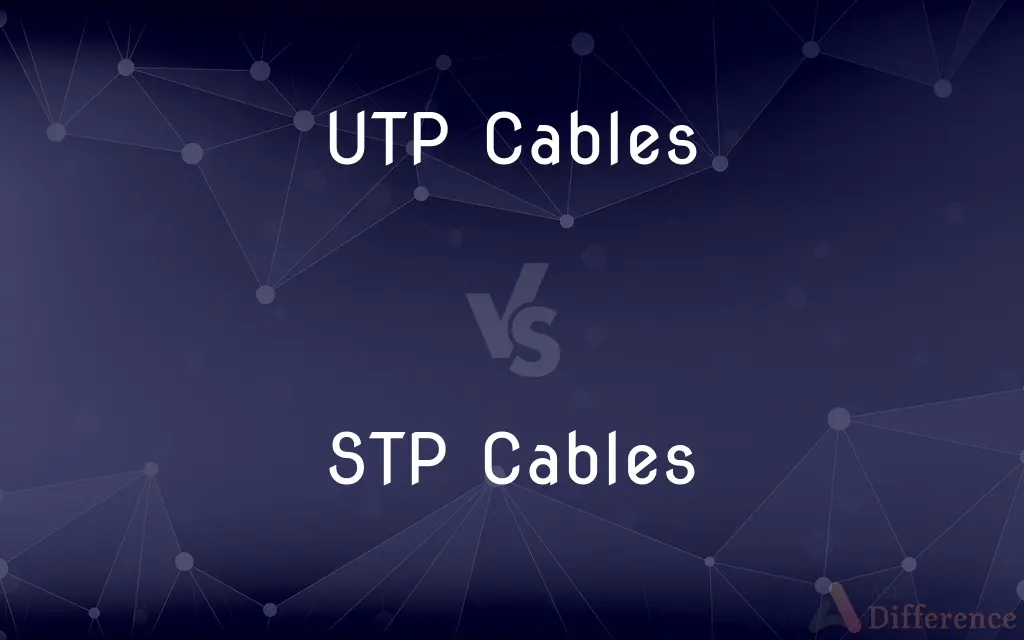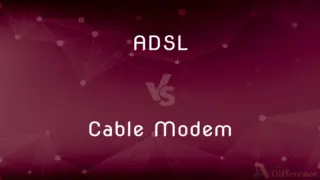UTP Cables vs. STP Cables — What's the Difference?
By Tayyaba Rehman — Published on January 4, 2024
UTP (Unshielded Twisted Pair) Cables use pairs of insulated wires for data transmission without shielding. STP (Shielded Twisted Pair) Cables employ additional shielding to reduce electromagnetic interference.

Difference Between UTP Cables and STP Cables
Table of Contents
ADVERTISEMENT
Key Differences
UTP Cables rely on twisted pairs of wires for signal transmission, lacking additional shielding against interference. STP Cables, with an added protective shield around twisted pairs, minimize electromagnetic interference, ensuring better data integrity.
In UTP Cables, data transmission occurs through twisted pairs without additional shielding, making them more susceptible to external electromagnetic interference. STP Cables, by contrast, incorporate shielding around twisted pairs, providing improved resistance to external interferences.
UTP Cables, commonly used in Ethernet connections, offer cost-effective solutions for shorter distances but may be more prone to signal degradation. STP Cables, preferred in environments with higher interference risks, ensure better data transmission quality due to their shielding.
UTP Cables' twisted pairs enable efficient data transmission but are more vulnerable to external electromagnetic fields. STP Cables, with their shielding, excel in environments with high interference, safeguarding data integrity during transmission.
Comparison Chart
Composition
Unshielded twisted pairs of wires
Shielded twisted pairs of wires
ADVERTISEMENT
Interference Resistance
More susceptible to electromagnetic interference
Better resistance to electromagnetic interference
Common Usage
Commonly used for shorter distances, cost-effective
Preferred in high-interference environments
Data Transmission Quality
May suffer signal degradation in noisy environments
Ensures better data integrity due to shielding
Vulnerability
Vulnerable to external interferences without shielding
Offers protection against external electromagnetic fields
Compare with Definitions
UTP Cables
Transmit data using unshielded twisted pairs.
UTP Cables utilize twisted pairs for data transmission in Ethernet networks without additional shielding.
STP Cables
Higher resistance to external electromagnetic fields.
The shielding in STP Cables offers increased resistance to external interferences, ensuring reliable data transmission.
UTP Cables
Efficient data transmission with twisted pairs.
The efficiency of UTP Cables lies in transmitting data effectively through twisted pairs of wires.
STP Cables
Ensure better data integrity with shielding.
STP Cables maintain data integrity by reducing the impact of external electromagnetic interference.
UTP Cables
Cost-effective solution for network connections.
UTP Cables offer a budget-friendly option for network connections within limited distances.
STP Cables
Use shielded twisted pairs for data transmission.
STP Cables employ shielding around twisted pairs, minimizing electromagnetic interference during data transmission.
UTP Cables
Commonly used in networking for shorter distances.
Ethernet connections often rely on UTP Cables due to their cost-effectiveness over shorter distances.
STP Cables
Preferred in high-interference environments.
In environments with high interference risks, STP Cables ensure better data transmission due to their shielding.
UTP Cables
More susceptible to interference without shielding.
UTP Cables might experience signal degradation in noisy environments due to their lack of shielding.
STP Cables
Resist electromagnetic interference efficiently.
The additional shielding in STP Cables provides effective protection against external electromagnetic fields.
Common Curiosities
What makes STP Cables preferable in certain network setups?
STP Cables are preferred in environments with higher interference risks as their shielding ensures better data transmission quality.
Are UTP Cables suitable for long-distance network connections?
UTP Cables are generally more suitable for shorter distances due to their susceptibility to signal degradation over extended lengths.
What are the common uses of UTP Cables in networking?
UTP Cables are commonly used in Ethernet connections, providing cost-effective solutions for shorter distance networks.
Are UTP Cables less expensive compared to STP Cables?
Yes, UTP Cables are typically more cost-effective due to their simpler construction without additional shielding.
Can UTP Cables handle environments with high electromagnetic interference?
UTP Cables might suffer from signal degradation in high-interference environments due to their lack of shielding.
How does the shielding in STP Cables benefit data transmission?
The shielding in STP Cables reduces electromagnetic interference, enhancing data integrity and transmission quality.
Are STP Cables suitable for critical data transmission?
Yes, STP Cables are preferred for critical data transmission due to their shielding, ensuring better data integrity.
Can UTP Cables be used in noisy environments?
UTP Cables might suffer signal degradation in noisy environments due to their vulnerability to external interference.
Can UTP Cables handle high-speed data transmission?
UTP Cables can manage high-speed data transmission effectively within their operational distance limitations.
How does shielding in STP Cables differ from UTP Cables' transmission?
STP Cables use shielding around twisted pairs to resist electromagnetic interference, which UTP Cables lack.
Can STP Cables completely eliminate electromagnetic interference?
While STP Cables offer better resistance, complete elimination of electromagnetic interference may not be possible in all scenarios.
What factors affect UTP Cables' performance?
UTP Cables' performance can be affected by external electromagnetic interference and the length of the cable.
Do STP Cables have limitations in terms of distance?
STP Cables are effective over longer distances but might have slight limitations compared to UTP Cables.
Are STP Cables more reliable than UTP Cables?
In high-interference environments, STP Cables offer more reliability due to their shielding compared to UTP Cables.
Can UTP Cables work efficiently in residential networking?
Yes, UTP Cables are commonly used in residential networking due to their cost-effectiveness and suitability for shorter distances.
Share Your Discovery

Previous Comparison
Present Perfect vs. Past Perfect
Next Comparison
ADSL vs. Cable ModemAuthor Spotlight
Written by
Tayyaba RehmanTayyaba Rehman is a distinguished writer, currently serving as a primary contributor to askdifference.com. As a researcher in semantics and etymology, Tayyaba's passion for the complexity of languages and their distinctions has found a perfect home on the platform. Tayyaba delves into the intricacies of language, distinguishing between commonly confused words and phrases, thereby providing clarity for readers worldwide.













































